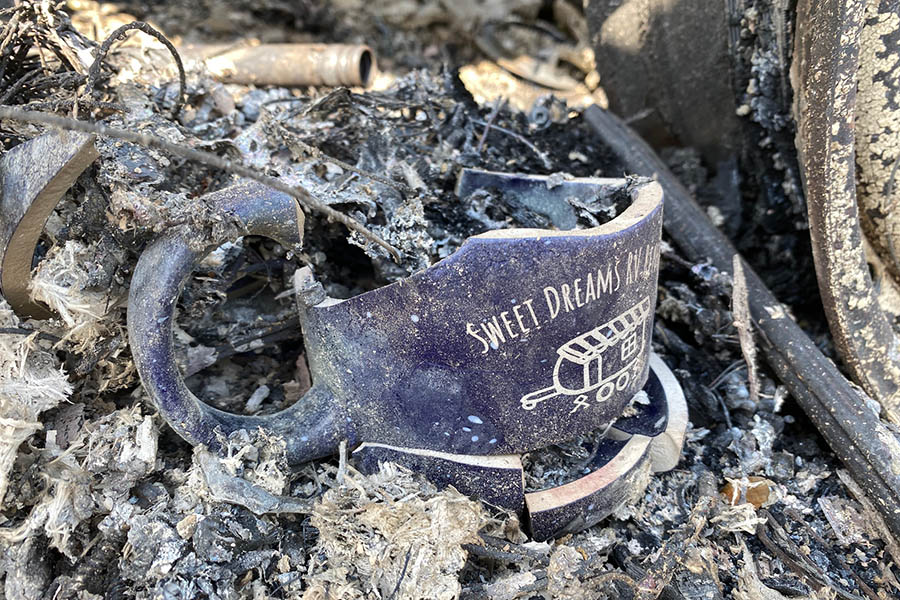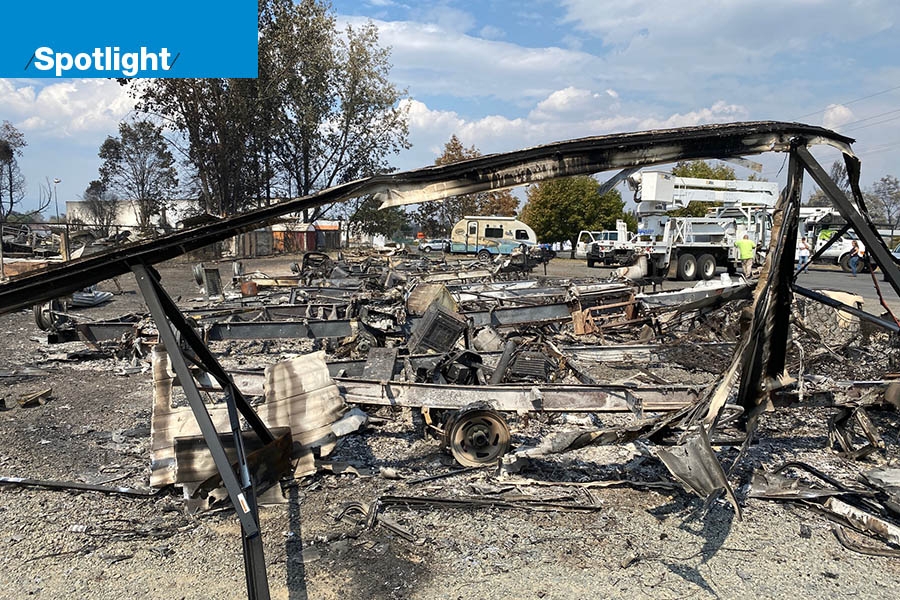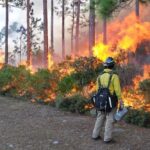The wildfires that destroyed communities and businesses in September pose a threat to the economy if nothing is done to prevent their spread.
In 2017 Heather Ayers purchased an RV to rent out to campers for short-term vacations. She came up with a unique business model that quickly proved popular. “Our big model was delivery. If people were camping up in the mountains, we would tow it up there for them, set it up, and all they’d have to do is show up and camp for a few days,” Ayers says. At the end of their trip, customers could simply leave. Ayers would pick up the trailer and tow it back down from the mountains.
The business grew enough that Ayers and her two partners purchased seven more trailers of various sizes and moved onto a commercial lot on Highway 99 in Phoenix, Oregon. “We started out by naming our first one Diego, after Diego Rivera. Our truck was Frida,” Ayers says. The rest were also named after artists or performers. There was Billie for Billie Holiday, Ringo for Ringo Starr, Nina for Nina Simone, and so on.
“They all had personality. Lucy was definitely one of the favorites because it was one of our biggest. She had double bunks and a super slide out, where you have a sofa bed and a dinette. It was like being in a little apartment when you got inside,” Ayers says.
“It was a great model. Our customers loved us. We had five-star reviews on Google.” She named her business Sweet Dreams RV Rentals.
When the coronavirus hit, bookings initially dried up. But people soon realized that camping was one of the few vacations that still worked well during a pandemic, and the customers quickly returned. “We were getting more than we could handle; we had to turn people away. We were really happy that our business had survived,” Ayers says.
 Post-fire site of Sweet Dreams RV Rentals Photo courtesy of Heather Ayers
Post-fire site of Sweet Dreams RV Rentals Photo courtesy of Heather Ayers
But in early September, hot dry weather and strong winds sparked major wildfires across Oregon.
The Alameda Drive fire was smaller than other fires that spread across large swathes of the Cascades, such as the Beachie Creek fire east of Salem, but the Alameda fire was particularly destructive because it swept through urban areas, incinerating homes and businesses in a matter of hours. It started in Ashland but quickly spread to the small city of Talent.
Ayers and her wife evacuated their house in Talent, fleeing to Medford and then to Grants Pass. “We were not even thinking of the fact that the fire would get to Phoenix and jeopardize our business. That was sort of a secondary thought,” Ayers says.
The Alameda fire ripped through Talent and quickly torched much of neighboring Phoenix, where her RV business was located. Oregon Gov. Kate Brown would later say that “it looked like a bomb went off” after touring the destruction in Southern Oregon.
“It just took out everything in its path. It took out our business and the Harley-Davidson shop next door,” Ayers recalls. “We were completely destroyed. It took everything down to the frames on all of our RVs.” Of the eight RVs owned by Sweet Dreams RV Rentals, seven were incinerated. The one remaining RV was rented out to a customer, so it was not on the lot that day.
The Alameda fire was only one of more than a dozen of large wildfires that swept through Oregon in September. The overall economic impact to the state is still unclear, but the damage is extensive. The fallout will hit a variety of sectors, including recreation, timber, real estate and agriculture.
State data shows that more than 4,000 residences burned across Oregon, with damage roughly adding up to around $1 billion. Many more people were also directly affected by suffocating smoke and evacuations. The Oregon Office of Economic Analysis estimates that around 2% of the state’s total population and about 1% of its total real estate market fell into the level 3 evacuation zone in September, comprising property valued at between $6 billion and $7 billion.
The cleanup and rebuilding of destroyed buildings in Southern Oregon alone could easily cost “hundreds of millions of dollars,” says Brad Hicks, president and CEO of the Chamber of Medford & Jackson County. It is too soon to put a precise number on the damage.
Then there are all of the burned trees. The timber industry and forest recreation together account for between 2% and 3% of the state’s economy. Between 800,000 and 1 million acres of forest were burned, according to various estimates. Marion County was hit hardest with more than 219,000 acres of forest burned, followed by Lane County at more than 154,000 acres. Jackson County — where the Alameda and the Obenchain fires hit — saw more than 35,000 acres of forest go up in flames.
Not all of the timber is lost, however. Even within burned areas, some trees are still standing. Some are fully intact, while others are charred but salvageable. Steven Ziegler, a senior forester for Mason, Bruce & Girard, a natural-resources consultancy, toured the damage of the Archie Creek fire along the North Umpqua River to see how much of the burned forest could be salvaged.
“The timber is still in pretty good condition. I think we can recover good value from the timber at this point, but it’s going to deteriorate pretty rapidly by next summer,” Ziegler says.
The charred trees will be worth less because some bark and mulch products would be contaminated and processing is trickier. “The mills also can’t run green logs and black logs at the same time,” Ziegler adds.
Aside from direct damage to timber and to homes and businesses, a larger impact could come from altered perceptions about the risk of living in Oregon. “The scariest potential impact for Oregon is that fewer households and investments may be attracted to the region moving forward,” Josh Lehner, an economist with the Oregon Office of Economic Analysis, wrote in a commentary in September. “Oregon’s primary comparative advantage remains its ability to draw skilled workers away from other states.”

Gov. Kate Brown surveys the Medford/Alameda fire from the air. Photo: Office of Gov. Kate Brown
Some economic research suggests that large wildfires tend to lead to more out-migration than some other natural disasters such as floods or hurricanes. If people and businesses perceive Oregon as a less desirable or riskier place to live due to increased danger from wildfire, they may move away or never move to Oregon in the first place.
If this occurs because of the 2020 fires, Oregon’s long-term economic outlook will “need to be lowered,” Lehner wrote. He added that this dynamic is the main long-run economic risk his office is concerned about.
Brad Hicks of the Medford Chamber agrees, adding that the hospitality industry in particular may see a lasting impact. “You can make a lot of choices on where you spend your travel dollars. Unless we get a handle on these wildfires and the issue of forest management, people are going to spend those dollars elsewhere,” he says.
The problem is that wildfire risk is only set to rise over time. While state and federal officials increasingly see the need for reforms to forest management, rising global temperatures ensure fire risk will continue to grow.
For every 1-degree Celsius increase in average temperatures, the annual area burned in the Pacific Northwest is expected to increase by two to three times, according to Jessica Halofsky, the director of the Western Wildland Environmental Threat Assessment Center.
But there is hope for reducing some of that extreme risk. A century of fire suppression has allowed dead wood to build up in forests. Returning fire to the landscape in a controlled way could reduce the odds that an ordinary wildfire erupts into a megafire.
“With wildfire, unlike tornadoes, we have a lever we can pull to reduce the risk: managing the fuels,” says John Bailey, a professor of silviculture and fire management at Oregon State University. “We are fairly certain that fire seasons will only get worse, at least most years. The quieter years are opportunities to take the necessary actions rather than forget the risk.”
RELATED STORY: Opinion: What Can We Do to Prevent Out-of-Control Wildfires?
In the wake of the widespread destruction, Oregon Sen. Ron Wyden introduced federal legislation that would boost funding for prescribed burns, a practice scientists say can reduce severe wildfire risk.
But for those living in Southern Oregon, there are more pressing concerns. The Alameda fire burned a huge portion of the local housing stock. “It’s impossible not to stay focused on the human-toll part of our story,” Hicks of the Chamber of Medford & Jackson County says.
The local housing market was already strained, and many people who lost their homes had lower incomes. In the immediate aftermath of the fire, the Jackson County Expo acted as an emergency shelter for displaced people who had nowhere to go.
As of early October, the Red Cross was paying for more than 300 people to stay in motels temporarily. Jackson County officials and a coalition of local groups are working on an interim housing solution — for the next 18 months or so — for where to house people as the region rebuilds. The county still has to grapple with a more permanent solution.
“We have huge residential losses in the thousands as well, and the assessment of that economic damage in property — and the resulting displaced workforce — is in the beginning stages as well,” says Jackson County Commissioner Colleen Roberts. “We are just getting started, and there is a very long road ahead.”
Ayers does not know what she will do next. She loves the community in Phoenix and Talent, and says the people are dedicated to rebuilding the area.
But for her RV business, difficult decisions lie ahead. Insurance covered her lost RVs, but not the rest of her business, including the office, computers, generators and other equipment. The insurance payout on the RVs was “not bad,” but she does not know if or how she will try to build the business back. “We put so much work into those three years,” she says.
“We don’t know if we have enough equity or energy to do it again,” she adds. “We don’t know how viable it is. We’d love to be in the same place, but then again, there’s nothing there right now.”
 Detail, post-fire site of Sweet Dreams RV Rentals Photo courtesy of Heather Ayers
Detail, post-fire site of Sweet Dreams RV Rentals Photo courtesy of Heather Ayers
At a Glance
Residences burned
4,000+
Estimated damages
$1billion
Acres of forest burned
800,000-1,000,000
Oregon Office of Economic Analysis







